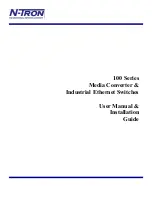
253
4.11 Authentication
This section is to control the access of the Managed Switch, includes the user access and management control.
The Authentication section contains links to the following main topics:
IEEE 802.1X Port-Based Network Access Control
MAC-Based Authentication
User Authentication
Overview of 802.1X (Port-Based) Authentication
In the 802.1X-world, the user is called the supplicant, the switch is the authenticator, and the RADIUS server is the authentication
server. The switch acts as the man-in-the-middle, forwarding requests and responses between the supplicant and the authentication
server. Frames sent between the supplicant and the switch are special 802.1X frames, known as
EAPOL (EAP Over LANs)
frames.
EAPOL frames encapsulate
EAP PDU
s (RFC3748). Frames sent between the switch and the RADIUS server are RADIUS packets.
RADIUS packets also encapsulate EAP PDUs together with other attributes like the switch's IP address, name, and the supplicant's
port number on the switch. EAP is very flexible, in that it allows for different authentication methods, like
MD5-Challenge
,
PEAP
,
and
TLS
. The important thing is that the authenticator (the switch) doesn't need to know which authentication method the supplicant
and the authentication server are using, or how many information exchange frames are needed for a particular method. The switch
simply encapsulates the EAP part of the frame into the relevant type (EAPOL or RADIUS) and forwards it.
When authentication is complete, the RADIUS server sends a special packet containing a success or failure indication. Besides
forwarding this decision to the supplicant, the switch uses it to open up or block traffic on the switch port connected to the supplicant.
Overview of MAC-Based Authentication
Unlike 802.1X, MAC-based authentication is not a standard, but merely a best-practices method adopted by the industry. In
MAC-based authentication, users are called clients, and the switch acts as the supplicant on behalf of clients. The initial frame (any
kind of frame) sent by a client is snooped by the switch, which in turn uses the client's MAC address as both username and
password in the subsequent EAP exchange with the RADIUS server. The 6-byte MAC address is converted to a string on the
following form "xx-xx-xx-xx-xx-xx", that is, a dash (-) is used as separator between the lower-cased hexadecimal digits. The switch
only supports the MD5-Challenge authentication method, so the RADIUS server must be configured accordingly.
When authentication is complete, the RADIUS server sends a success or failure indication, which in turn causes the switch to open
up or block traffic for that particular client, using static entries into the MAC Table. Only then will frames from the client be forwarded
on the switch. There are no EAPOL frames involved in this authentication, and therefore, MAC-based Authentication has nothing to
do with the 802.1X standard.
The advantage of MAC-based authentication over 802.1X is that several clients can be connected to the same port (e.g. through a
Summary of Contents for NS4702-24P-4S-4X
Page 1: ...NS4702 24P 4S 4X User Manual P N 1072829 REV 00 01 ISS 14JUL14 ...
Page 23: ...23 Storage Temperature 10 70 degrees C Relative Humidity 5 95 non condensing ...
Page 164: ...164 Figure 4 8 2 Multicast Flooding ...
Page 183: ...183 Figure 4 8 14 IGMP Snooping VLAN Configuration Page Screenshot ...
Page 189: ...189 Figure 4 8 17 MLD Snooping Groups Information Page Screenshot ...
Page 208: ...208 Figure 4 9 6 QoS Egress Port Tag Remarking Page Screenshot ...
Page 218: ...218 Deletes the QCE The lowest plus sign adds a new entry at the bottom of the list of QCL ...
Page 229: ...229 Figure 4 9 18 Voice VLAN Configuration Page Screenshot ...
Page 299: ...299 Figure 4 11 17 Add User Properties Screen Figure 4 11 18 Add User Properties Screen ...
Page 336: ...336 Figure 4 14 2 LLDPMED Configuration Page Screenshot ...
Page 357: ...357 Figure 4 15 4 VeriPHY Cable Diagnostics Page Screenshot ...
Page 367: ...367 ...
Page 391: ...391 ...
















































